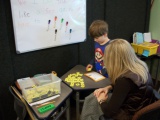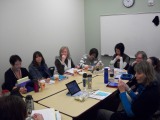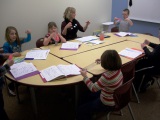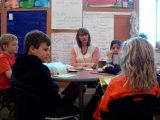-
Category 1
Selected in 2013
-
Grades: k - 5
School Setting: rural
Town Population: 6,308
Student Enrollment: 318
Student Demographics:
Black/African American: 0%
Teacher/Student Ratio: 1:17
White/Caucasian: 84%
Hispanic: 15%
Hawaiian/Pacific Islander: 0%
Asian: 1%
Native American: 0%
Other: 0%
% Reduced Lunch: 46%
% ELL Learners: 4%
Founded: 1956 -
PRINCIPAL:
Scott Schiller -
CONTACT:
278 East Monroe st.
Powell, WY 82435
307-764-6183
srs@pcsd1.net
Southside Elementary School
Powell, WY
We continue to grow and learn as a team, acquire new strategies to enhance learning, research new programs and techniques to support instruction, but most importantly, we ALWAYS keep our focus on our students and their learning.
- Describe specific programs in place to ensure that families are involved in the success of your school and students.
-
Southside offers the following programs that encourage family involvement: Yearly Scholastic Book Fairs, Title I Family Nights, Love and Logic Parenting Classes, Monthly Student Award Assemblies, Evening Parent/Teacher Conferences, Afterschool Programming, Bi-Monthly Newsletters, and Family Movie Nights.
Title I Family Nights promote reading with your child while offering activities, strategies, and incentives that encourage families to read together and connect reading to success in school.
Love and Logic is an eight-week course offered twice per year for adults interested in parenting strategies that promote positive relations at home and school.
Celebration is important to our Southside Community. Each month we invite families to join with us to celebrate the achievements of our students. This red carpet event recognizes approximately one third of our students each month with music, dancing, pictures, medals, certificates, and lots of applause.
- Describe the most successful activity your school has initiated to strengthen ties to your community.
- Our Title I program at Southside Elementary School strengthens ties with our parents and community by offering three Title I nights during the school year. At the beginning of every year, our first Title I Reading Night is to celebrate our summer reading achievement and offer parents and the community a look at how Southside Elementary School encourages students to continue reading during the summer months. Our second parent night always takes place during parent/teacher conferences allowing parents to meet with our Teachers and Title I staff with any concerns or questions about their child’s program. Our third parent night is at the end of the school year. We choose an exciting theme that motivates our students to set and work towards a new school wide summer reading goal.
- Describe your philosophy of school change or improvement.
-
Our ten-year journey as a Professional Learning Community has led us to embrace change and particularly school improvement by establishing a clear purpose, adopting a collaborative culture, and focusing on results.
We begin every school year by collecting data. Our collaborative teams meet to analyze the data and develop building-wide and grade level SMART goals. These SMART goals focus on specific areas of deficit in reading and math while targeting disaggregated data such as Free and Reduced lunch, Special Education, Gender, etc. Our weekly collaborative team meetings focus on specific student needs and targeted areas for improvement. We gather formative data to establish intervention/enrichment groups, which we provide twice daily to address these needs in reading and math.
Our philosophy is that all students can/will learn, and we as a community of learners will do “whatever it takes” to ensure student learning.
- What are your school’s top two goals for the next year?
- With the adoption of our new Wyoming Standards in Math and English Language Arts, our process for goal setting remains the same. We review all data available to us such as our state testing, map testing, DIBELS, CBM, and local assessments. We then establish our school, grade level, classroom, and personal professional SMART goals. This data has led us to set goals primarily in Math, Reading, and Writing. If we had to narrow it down to two goals, it is that 87% of our students will be reading at grade level by the end of the 2013-14 school year based on our state testing, DIBELS, and MAP assessment. Our second goal is that 86% of our students will demonstrate grade level proficiency on local and state assessments in math by the end of the 2013-14 school year based on the state assessment, MAP testing, and the CBM. We also maintain a third goal of 80% writing proficiency by the end of the 2013-14 school year..
- What is the single most important factor in the success of your school that others could replicate?
-
Upon setting SMART Goals to improve student reading, we realized the need to intervene with more of our students, not just the intensive.That is when we began the school-wide reading intervention. Interventions for Early Literacy and School-wide DIBELS are set up in two different formats. Our team groups the Intensive students by grade and according to areas of deficit. We then select a Scientifically Research Based Program (SRBP) to use with students. We keep the group size to four or less and the Early Literacy instructor works with these students three times per week for 30 minutes. These students are then progress monitored twice monthly. The same students are also placed into a School-wide intervention where once again, they are assigned to another SRBP which is different from the one used in their Early Literacy Intervention. However, we do not restrict these groups to just Intensive students. We provide interventions/enrichment for ALL K-5 students based on the screener.
- Describe the program or initiative that has had the greatest positive effect on student achievement, including closing achievement or opportunity gaps, if applicable.
-
The initiative that has had the greatest positive impact on student achievement in reading has been the creation of our daily School-wide Reading Intervention Groups. Using the DIBELS screening tool, we assess the entire student body three times per year. Our collaborative teams, including Title I staff, analyze the data and place students in groups according to their specific needs. For our most intensive students, we provide very systematic and targeted instruction led by our most qualified and certified instructors, while utilizing research based reading programs. These students are progress monitored bi-monthly while we monitor the strategic students monthly. We take the data to our grade level team meetings to analyze and adjust instruction accordingly. In Math, the initiative with the most impact has been our daily grade level intervention times, again employing our entire Title I staff. We form intervention groups after collecting and analyzing necessary data.
- Explain how Title I funds are used to support your improvement efforts.
- Title I funds afford our school one full time certified educator and three part time para-professionals. Title I staff are integral in our system of interventions that support reading and math. After assessment and instruction take place in these areas, formative assessments are given, the teacher brings their results to grade level team meetings (including Title I staff), where the team then analyzes the data and students are placed in small groups to receive intervention/enrichment. Every 30-minute intervention period includes Title I staff, grade level teachers, para's, Special Ed. staff, and each student group. After administering a second formative at the completion of a specified intervention time, we determine if additional intervention or regrouping is required. Title I funds have also allowed us to create an additional 30 minute daily intervention period to provide support for our K-2 Early Literacy students who have been identified at-risk through our DIBELS Screening Tool.
- Identify the critical professional development activities you use to improve teaching and student learning.
-
Our educators are fortunate to work in a district that allows for, and understands the importance of professional development at the local, regional, and national levels.
Our school has developed a schedule that allows for common planning time each day along with monthly vertical articulation meetings (vertical meetings are held during monthly student celebrations). Within the daily planning, one - two times per week, our teams -- including Title I Staff, Instructional Facilitator, Special Ed.Staff, and Para-professionals, meet to confer and collaborate about students and their learning.
Our district grade level staff meets twice per month to collaborate and develop units, lesson plans, and assessments.
Many leading professionals have presented to our entire district on relevant topics such as Assessment, Professional Learning Communities, Common Core, Students of Poverty, and last, they value our staff enough to provide a motivational speaker at the beginning of each new year.
- Describe how data is used to improve student achievement and inform decision making.
- Southside Elementary (a model PLC school) is a school that utilizes data to inform all decisions concerning student learning and goal setting. At the beginning of the year, we use multiple sources for acquiring student data (State Assessment, MAP, DIBELS, and CBM) when creating our building wide and grade level SMART Goals. We use this data to set our K-5 school wide reading intervention groups that take place for 30 minutes each day. We also use this data to support our daily 30-minute grade level interventions in math and reading. Continuous progress monitoring takes place over the course of the school year and we revisit our SMART Goals again after winter and spring assessment. It should be noted that our instructional facilitator (instructional coach) plays a critical role in accumulating, analyzing, and distributing the student data to the staff in an understandable format.
- Describe your school culture and explain changes you’ve taken to improve it.
-
Southside began its journey as a Professional Learning Community eight years ago by making a commitment to working as a high performing school in order to meet the needs of all students. We started by creating a shared belief that all students could learn and we would do whatever it takes to achieve that belief. We had to look outside the traditional box and envision what this would look like in our school setting. Over several years, our staff has worked to create schedules that allow for collaboration vertically and horizontally among ALL staff.
We remain committed to continual modeling and practice of what high performing collaborative teams can do to improve learning for all our students. We continue to grow and learn as a team, acquire new strategies to enhance learning, research new programs and techniques to support instruction, but most importantly, we ALWAYS keep our focus on our students and their success.
Stats
-
Category 1
Selected in 2013
-
Grades: k - 5
School Setting: rural
Town Population: 6,308
Student Enrollment: 318
Student Demographics:
Black/African American: 0%
Teacher/Student Ratio: 1:17
White/Caucasian: 84%
Hispanic: 15%
Hawaiian/Pacific Islander: 0%
Asian: 1%
Native American: 0%
Other: 0%
% Reduced Lunch: 46%
% ELL Learners: 4%
Founded: 1956 -
PRINCIPAL:
Scott Schiller -
CONTACT:
278 East Monroe st.
Powell, WY 82435
307-764-6183
srs@pcsd1.net












